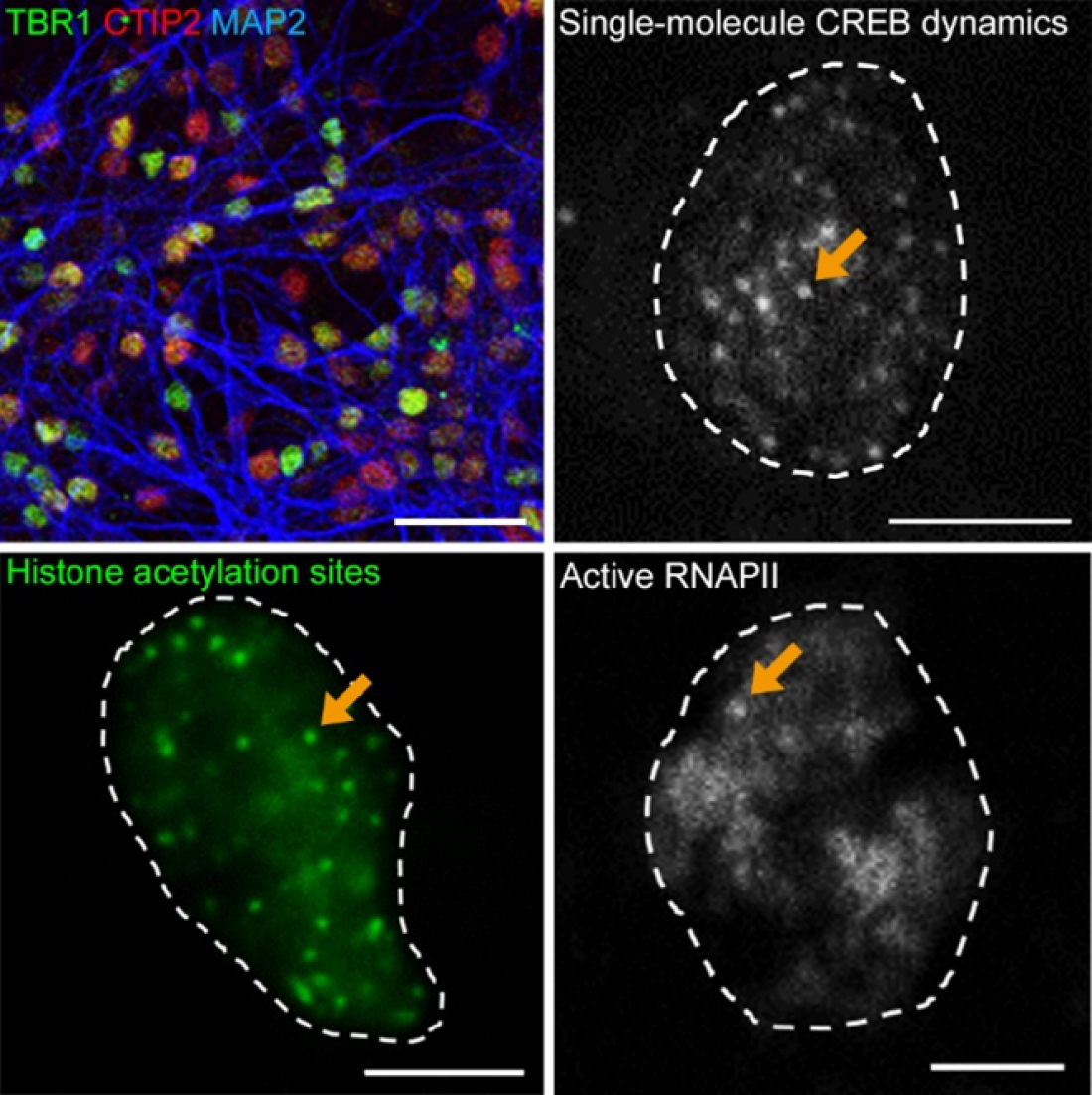In human ES cell-derived cortical neurons (upper left), single-molecule CREB dynamics was observed (upper right). Activity-dependent repetitive CREB binding to DNA occurred at histone acetylation sites (lower left), where active RNAPII accumulation induces gene expression (lower right). Dashed lines indicate the outline of the nucleus. Scale bars: 50 µm (top left) and 5 µm (others). Licence: Original content. Credit must be given to the creator.
Researchers from Osaka University find that neuronal activity induces gene expression at the preprepared histone acetylation sites in the nucleus by influencing transcription factors and chromatin modifiers
Osaka, Japan – No man is an island, and no neuron is either: complex, intricate connections between and among brain cells are needed for the brain to do its job right. Now, researchers from Japan have uncovered a fundamental mechanism that lets neurons know when and how to form these connections.
In a study recently published in Cell Reports, researchers from Osaka University and Shenzhen Bay Laboratory have revealed the behavior of proteins linked to learning and memory in human brain cells.
In the developing brain, neuronal activity stimulates the expression of genes that are needed for brain cells to grow and form connections. If this process is disrupted, developmental and psychiatric disorders can develop.
“The transcription factor cAMP response element binding protein (CREB) is required for the brain to learn and form memories,” says lead author of the study Yuri Atsumi. “While CREB and CREB binding protein (CBP) are known to interact to stimulate gene expression in the developing brain, it is unclear how neuronal activity affects this interaction.”
To explore this, the researchers used a sophisticated microscopy technique called single-molecule imaging to track the movements of CREB and CBP in human brain cells.
“The results were very clear,” explains co-senior author Noriyuki Sugo. “We found that neuronal activity markedly increased repetitive, long-term interactions between CREB and DNA and between CREB and CBP.”
These interactions attracted RNA polymerase II, which activates gene expression. Furthermore, the researchers discovered that the sites where CREB interacted with DNA to promote gene expression require prior acetylation mediated by CBP.
“These findings not only elucidate the mechanism underlying learning and memory in developing brain, but also offer new insight into how psychiatric disorders may develop,” says co-senior author Nobuhiko Yamamoto.
Given that CBP is a gene that can cause Rubinstein–Taybi syndrome, in which patients show mental retardation and intellectual disability, inactivation of the CBP protein could help explain how this disease develops. Exploring CREB-CBP interactions further in 3D brain-like models could yield additional insight into the effects of neuronal activity observed in this study.
###
The article, “Repetitive CREB-DNA interactions at gene loci predetermined by CBP induce activity-dependent gene expression in human cortical neurons,” was published in Cell Reports at DOI: 10.1016/j.celrep.2023.113576
About Osaka University
Osaka University was founded in 1931 as one of the seven imperial universities of Japan and is now one of Japan's leading comprehensive universities with a broad disciplinary spectrum. This strength is coupled with a singular drive for innovation that extends throughout the scientific process, from fundamental research to the creation of applied technology with positive economic impacts. Its commitment to innovation has been recognized in Japan and around the world, being named Japan's most innovative university in 2015 (Reuters 2015 Top 100) and one of the most innovative institutions in the world in 2017 (Innovative Universities and the Nature Index Innovation 2017). Now, Osaka University is leveraging its role as a Designated National University Corporation selected by the Ministry of Education, Culture, Sports, Science and Technology to contribute to innovation for human welfare, sustainable development of society, and social transformation.
Website: https://resou.osaka-u.ac.jp/en



